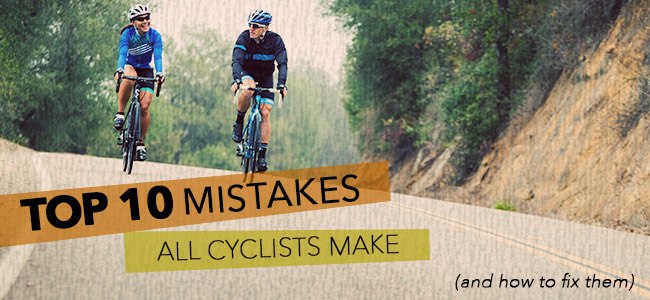Top 10 Cycling Mistakes

The 10 Biggest Cycling Mistakes and How to Fix Them
No matter whether mountain bikers or road riders, cyclists are often their own worst enemies when it comes to training. Too much of one thing or too little of another can undermine all of your hard efforts. Repair your routine and get back on track by eliminating these ten common mistakes.
#1 Ignoring Sleep
When you train hard, your body needs some downtime to recover. Remember, it is not the training and tearing of muscle that makes you stronger, it is the rebuilding of that tissue to handle the greater stress that provides the improvement. Sleep is where that happens.
#2 Forgetting to practice Bike Handling
With Fall and cyclocross season approaching, there has never been a better time to brush up on your handling skills. If you are usually a road rider, jump on your mountain bike and take a challenging trail ride. Or, consider picking up a cyclocross bike to rip around in the gravel, leaves and mud that are on the way.
#3 Neglecting the rest of your body
Cyclists are notorious for concentrating on their riding legs and not exercising their upper body or core. Working your shoulders with some alternating pulling and pressing exercises will add stamina and comfort to your longer rides. Crunches and core exercise will help bear the load of your upper body even more. Collectively, new levels of endurance and comfort can be found with a balanced workout program.
#4 Not getting your bike fitted
Your bike needs to fit you properly in order to be comfortable. Saddle height and reach to the handlebars are fundamental dimensions that need to be correct for you to have proper form on the bike. Tweak these adjustments yourself and take notes on the results or take the fast track to comfort—a professional bike fit session.
#5 Not timing your meals
Work and kids and a hundred other things can get in the way, but you need to have food at the right time to perform on the bike. Eat a good meal before a long ride. You can’t go far with no gas in the tank. Similarly, when you finish a long ride, be sure to replenish your energy stores with a meal shortly after.
#6 Thinking more is better
The More-On Theory states—“If a little is good, more is better”—and is commonly applied to ketchup, bike accessories and training. While it is good to train hard, there is a limit to how much your body can take in a short time. Listen to your body. If you feel tired on a ride, it may actually be that you are tired, not that you need to train more.
#7 Relying on bars and gels
Convenient and powerful as they may be, energy bars or gels should not replace proper nutrition before and after a ride. All rides should begin with a recent meal and a feeling of being ready to go. Starting hungry and chowing down on the powerfood buffet may work on occasion, but is not a good long-term plan. Pre-fuel for your ride with real food and use the bars, gels and drinks to keep your energy level up during the ride.
#8 Doing too much long and slow distance riding
You only get out what you put in. It is tough to be a rocket on the hills if you only ride a steady pace on the flats. Mix up your training to include things that you are not currently good at. Climb some hills. Sprint to road signs ahead. The more varied your training, the more of an all-rounder you will become as a cyclist.
#9 Worrying about fat sugar and salt
Assuming you are not dealing with a serious health problem, you can ease off worrying about fat, sugar and salt during riding season. If you are racking up the miles each week, you will also be burning off loads of fat, eating sugars in energy bars and sweating out shakers of salt. Don’t be excessive with your intake of these things, but concentrate more on riding than counting grams of fat.
#10 Training like a pro cyclist
While there is much to be learned from professional athletes, the average rider needs to understand their limitations and train appropriately. Motivation and enthusiasm are great, just beware of overtraining and over-use injuries. Even pros use a stepped training regimen that increases their work load only as their bodies adapt and are able to handle the stress. Ride hard, but don’t overdo it.
